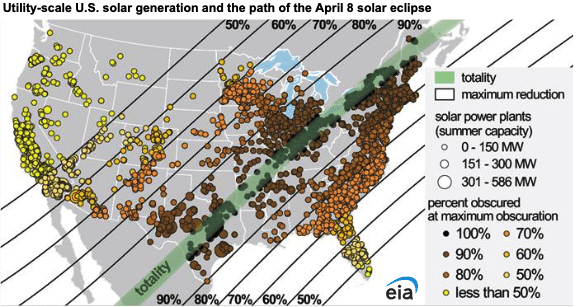Solar Eclipse on April 8 to Briefly Impact Solar Electricity Production Across the U.S.: EIA

A full solar eclipse on April 8 is expected to limit solar electricity generation for a short time across the U.S., according to the U.S. Energy Information Administration. The solar eclipse will temporarily but completely obscure sunlight to solar generation assets from Texas through Maine, impacting 6.5 gigawatts (GW) of capacity. Moreover, the solar eclipse will partially block sunlight to facilities with a total capacity of 84.8 GW across a larger area of the U.S. around the peak production period.
In the path of totality, the area where the moon will completely block the sun, solar generating assets are most affected as direct sunlight will be blocked for over four minutes. Meanwhile, the partial eclipse may perhaps restrict sunshine in the path of totality for more than two hours, however areas around the path of totality will have variable levels of lower solar production.
Utilities across the U.S. have strategically prepared for the reduction in solar energy. Grid authorities in preparation have issued plans for their tactics on how they will tackle solar production during the eclipse. Electricity generators are equipped to replace the reduction in solar production, with other sources of electricity production, in order for the system to remain well supplied.
The solar eclipse will impact the electricity grid in two ways. First, utility-scale solar generation, primarily managed by balancing authorities, will experience reduced output during the eclipse, prompting system operators to deploy alternative generating resources. Homes and businesses equipped with small-scale solar systems will rely more on grid electricity, as these systems are not under balancing authority control, potentially leading to an overall increase in grid power demand. Second, battery storage plays a crucial role in the grid’s response to the eclipse, helping balance electricity supply by storing excess solar or wind generation during low-demand periods and discharging it during peak demand. In the United States, there is currently 15.4 GW of battery storage capacity, a significant increase compared to the 0.6 GW operational during the 2017 solar eclipse.
The states most impacted by the solar eclipse will be Texas and California. Texas will lose around 90 to 99 percent of solar power during the eclipse. California is in the 40 to 59 percent partial reduction range, however the state’s significant use of utility- and small-scale solar capacity makes the eclipse’s impact more substantial.
The impact of the 2017 solar eclipse on the electricity grid was negligible. However, the U.S. power portfolio has significantly changed since, with around 100 GW of solar capacity added to the system since then.
EnerKnol Pulses like this one are powered by the EnerKnol Platform—the first comprehensive database for real-time energy policy tracking. Sign up for a free trial below for access to key regulatory data and deep industry insights across the energy spectrum.
ACCESS FREE TRIAL